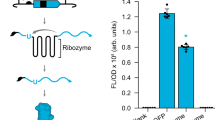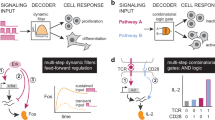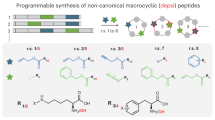Abstract
We generated synthetic protein components that can detect specific DNA sequences and subsequently trigger a desired intracellular response. These modular sensors exploit the programmability of zinc-finger DNA recognition to drive the intein-mediated splicing of an artificial trans-activator that signals to a genetic circuit containing a given reporter or response gene. We used the sensors to mediate sequence recognition−induced apoptosis as well as to detect and report a viral infection. This work establishes a synthetic biology framework for endowing mammalian cells with sentinel capabilities, which provides a programmable means to cull infected cells. It may also be used to identify positively transduced or transfected cells, isolate recipients of intentional genomic edits and increase the repertoire of inducible parts in synthetic biology.
This is a preview of subscription content, access via your institution
Access options
Subscribe to this journal
Receive 12 print issues and online access
$259.00 per year
only $21.58 per issue
Buy this article
- Purchase on Springer Link
- Instant access to full article PDF
Prices may be subject to local taxes which are calculated during checkout






Similar content being viewed by others
References
Maeder, M.L. et al. Rapid “open-source” engineering of customized zinc-finger nucleases for highly efficient gene modification. Mol. Cell 31, 294–301 (2008).
Kim, S., Lee, M.J., Kim, H., Kang, M. & Kim, J.S. Preassembled zinc-finger arrays for rapid construction of ZFNs. Nat. Methods 8, 7 (2011).
Tebas, P. et al. Gene editing of CCR5 in autologous CD4 T cells of persons infected with HIV. N. Engl. J. Med. 370, 901–910 (2014).
Ooi, A.T., Stains, C.I., Ghosh, I. & Segal, D.J. Sequence-enabled reassembly of beta-lactamase (SEER-LAC): A sensitive method for the detection of double-stranded DNA. Biochemistry 45, 3620–3625 (2006).
Khalil, A.S. et al. A synthetic biology framework for programming eukaryotic transcription functions. Cell 150, 647–658 (2012).
Lohmueller, J.J., Armel, T.Z. & Silver, P.A. A tunable zinc finger-based framework for Boolean logic computation in mammalian cells. Nucleic Acids Res. 40, 5180–5187 (2012).
Keung, A.J., Bashor, C.J., Kiriakov, S., Collins, J.J. & Khalil, A.S. Using targeted chromatin regulators to engineer combinatorial and spatial transcriptional regulation. Cell 158, 110–120 (2014).
Gaj, T., Gersbach, C.A. & Barbas, C.F. 3rd ZFN, TALEN, and CRISPR/Cas-based methods for genome engineering. Trends Biotechnol. 31, 397–405 (2013).
Kane, P.M. et al. Protein splicing converts the yeast TFP1 gene product to the 69-kD subunit of the vacuolar H(+)-adenosine triphosphatase. Science 250, 651–657 (1990).
Hirata, R. et al. Molecular structure of a gene, VMA1, encoding the catalytic subunit of H(+)-translocating adenosine triphosphatase from vacuolar membranes of Saccharomyces cerevisiae. J. Biol. Chem. 265, 6726–6733 (1990).
Mootz, H.D. & Muir, T.W. Protein splicing triggered by a small molecule. J. Am. Chem. Soc. 124, 9044–9045 (2002).
Schwartz, E.C., Saez, L., Young, M.W. & Muir, T.W. Post-translational enzyme activation in an animal via optimized conditional protein splicing. Nat. Chem. Biol. 3, 50–54 (2007).
Zeidler, M.P. et al. Temperature-sensitive control of protein activity by conditionally splicing inteins. Nat. Biotechnol. 22, 871–876 (2004).
Tyszkiewicz, A.B. & Muir, T.W. Activation of protein splicing with light in yeast. Nat. Methods 5, 303–305 (2008).
Selgrade, D.F., Lohmueller, J.J., Lienert, F. & Silver, P.A. Protein scaffold-activated protein trans-splicing in mammalian cells. J. Am. Chem. Soc. 135, 7713–7719 (2013).
Huang, X. et al. Sequence-specific biosensors report drug-induced changes in epigenetic silencing in living cells. DNA Cell Biol. 31 (suppl. 1), S2–S10 (2012).
Kim, J.S. & Pabo, C.O. Getting a handhold on DNA: design of poly-zinc finger proteins with femtomolar dissociation constants. Proc. Natl. Acad. Sci. USA 95, 2812–2817 (1998).
Liu, Q., Segal, D.J., Ghiara, J.B. & Barbas, C.F. III. Design of polydactyl zinc-finger proteins for unique addressing within complex genomes. Proc. Natl. Acad. Sci. USA 94, 5525–5530 (1997).
Nogami, S., Satow, Y., Ohya, Y. & Anraku, Y. Probing novel elements for protein splicing in the yeast Vma1 protozyme: A study of replacement mutagenesis and intragenic suppression. Genetics 147, 73–85 (1997).
Ozawa, T., Nishitani, K., Sako, Y. & Umezawa, Y. A high-throughput screening of genes that encode proteins transported into the endoplasmic reticulum in mammalian cells. Nucleic Acids Res. 33, e34 (2005).
Sonntag, T. & Mootz, H.D. An intein-cassette integration approach used for the generation of a split TEV protease activated by conditional protein splicing. Mol. Biosyst. 7, 2031–2039 (2011).
Chong, S. & Xu, M.Q. Protein splicing of the Saccharomyces cerevisiae VMA intein without the endonuclease motifs. J. Biol. Chem. 272, 15587–15590 (1997).
Elrod-Erickson, M., Rould, M.A., Nekludova, L. & Pabo, C.O. Zif268 protein-DNA complex refined at 1.6 angstrom: A model system for understanding zinc finger-DNA interactions. Structure 4, 1171–1180 (1996).
Cobb, L.M. et al. 2,4-dinitro-5-ethyleneiminobenzamide (CB 1954): a potent and selective inhibitor of the growth of the Walker carcinoma 256. Biochem. Pharmacol. 18, 1519–1527 (1969).
Knox, R.J., Friedlos, F. & Boland, M.P. The bioactivation of CB 1954 and its use as a prodrug in antibody-directed enzyme prodrug therapy (ADEPT). Cancer Metastasis Rev. 12, 195–212 (1993).
Grohmann, M. et al. A mammalianized synthetic nitroreductase gene for high-level expression. BMC Cancer 9, 301 (2009).
Lion, T. Adenovirus Infections in Immunocompetent and Immunocompromised Patients. Clin. Microbiol. Rev. 27, 441–462 (2014).
Bogdanove, A.J. & Voytas, D.F. TAL effectors: customizable proteins for DNA targeting. Science 333, 1843–1846 (2011).
Filipovska, A. & Rackham, O. Designer RNA-binding proteins New tools for manipulating the transcriptome. RNA Biol. 8, 978–983 (2011).
Maxwell, I.H., Maxwell, F. & Glode, L.M. Regulated expression of a diphtheria toxin A-chain gene transfected into human cells: possible strategy for inducing cancer cell suicide. Cancer Res. 46, 4660–4664 (1986).
Yu, J., Zhang, L., Hwang, P.M., Kinzler, K.W. & Vogelstein, B. PUMA induces the rapid apoptosis of colorectal cancer cells. Mol. Cell 7, 673–682 (2001).
Xie, Z., Wroblewska, L., Prochazka, L., Weiss, R. & Benenson, Y. Multi-input RNAi-based logic circuit for identification of specific cancer cells. Science 333, 1307–1311 (2011).
Koch, J., Steinle, A., Watzl, C. & Mandelboim, O. Activating natural cytotoxicity receptors of natural killer cells in cancer and infection. Trends Immunol. 34, 182–191 (2013).
Banerjee, C. et al. BET bromodomain inhibition as a novel strategy for reactivation of HIV-1. J. Leukoc. Biol. 92, 1147–1154 (2012).
Nambiar, M., Kari, V. & Raghavan, S.C. Chromosomal translocations in cancer. Biochim. Biophys. Acta 1786, 139–152 (2008).
Dekker, J., Marti-Renom, M.A. & Mirny, L.A. Exploring the three-dimensional organization of genomes: interpreting chromatin interaction data. Nat. Rev. Genet. 14, 390–403 (2013).
Acknowledgements
We thank S. Modi for helpful discussions and critical reviews of the manuscript. HEK293FT cells were donated by members of the R. Weiss laboratory (MIT, Cambridge, Massachusetts, USA). This work was supported by funding from the Defense Advanced Research Projects Agency (grant DARPA-BAA-11-23), the Defense Threat Reduction Agency (grant HDTRA1-14-1-0006) and the Air Force Office of Scientific Research (AFOSR-BRI grant FA9550-14-1-0060).
Author information
Authors and Affiliations
Contributions
S.S. and J.J.C. conceived the study, analyzed data and wrote the paper. S.S. designed and performed the experiments.
Corresponding author
Ethics declarations
Competing interests
The authors declare no competing financial interests.
Integrated supplementary information
Supplementary Figure 1 Tridactyl ZF-TF binding and intein fusion.
(a) Schematic of ten members of an OPEN ZF library (ZF1–ZF10) that were fused to VP64 at their C-terminus and co-transfected into HeLa (b) or HEK 293FT (c) cells with their respective GFP reporter constructs to assess ZF binding in the human cell nucleus. GFP fluorescence of biological duplicates is overlaid. Grey bars indicate basal reporter activity without ZF-TFs. (d) Electrophoresis mobility shift assay (EMSA) of a tridactyl ZF fused to the intein domains (IN and IC).
Supplementary Figure 2 Intracellular binding assay of hexadactyl ZF-TFs constructed via merging of two tridactyl ZFs.
a) Reporter constructs contained a contiguous 18 bp operator corresponding to the nine bp binding sites of the two tridactyl ZFs comprising each hexadactyl protein (0gap). Constructs containing an operator with one or two unrelated nucleotides separating the two nine bp binding sites (1gap or 2gap) were tested, as well. The related tridactyl ZF-TFs were retested in order to compare their activation levels to those achieved with the hexadactyl ZF-TFs. (b) and (c) are GFP fluorescence measured in HEK 293FT and HeLa cells, respectively. GFP fluorescence of biological duplicates is overlaid. Grey bars indicate basal reporter activity without ZF-TFs.
Supplementary Figure 3 IC and IN domains fused to tridactyl or hexadactyl ZFs and tested for intracellular GFP activation.
IC and IN domains were fused to tridactyl ZFs or hexadactyl ZFs and tested for intracellular GFP activation (with VP64 as a trans-activation domain) as described in Fig. 2., in both HeLa (a) and HEK 293FT (b) cells. (c) Flexible linkers of 1×, 2×, or 3× (GGGS)3 were inserted between the hexadactyl ZF domains and the split intein domains to identify a length for improved binding. All lengths enabled binding for both intein fusions, in HeLa and HEK 293FT cells, with a mild advantage seen for the 2× linker in HeLa (d) and HEK 293FT (e) cells. GFP fluorescence of biological duplicates is overlaid. Grey bars indicate basal reporter activity without ZF-TFs.
Supplementary Figure 4 Tandem repeats of ZF9-TF operator site inserted into a response circuit for greater dynamic range.
(a) Schematic: ZF9-TF was expressed in HEK 293FT cells with a response circuit containing 0×, 1×, 2×, 4×, or 6× tandem repeats of the nine bp ZF9 operator site, modulating GFP expression. With the number of sites, activity increased (b) and basal activity decreased (c). (d) No cross-reactivity between hexadactyl sensor proteins and the response circuit was detected. GFP fluorescence of biological duplicates is overlaid. (e) Microscopy of cells transfected as described in (a). Scale bar is 50 μM.
Supplementary Figure 5 Split extein and splice-junction (SJ) design, construction and cis-splice validation.
(a) Schematic: splice junction (SJ) design of ZF9-TF variants (V1,V3) as described for Fig. 3a. (b) ZF9-TF and variants (V1,2,3) were expressed in HeLa (left) and HEK 293FT (right) cells with the 6× ZF9 operator site GFP circuit. (c) The three ZF9-TF variants were split and fused to the appropriate split intein domains, which were directly tethered to one another, as described in Fig. 3b, and termed, CIS-V1, V2 and V3. Proteins were expressed in HEK 293FT cells with the 6× ZF9 reporter to assess cis-splicing of the split ZF9-TF variants and their subsequent trans-activation of GFP expression. GFP fluorescence of biological duplicates is overlaid. (d) To abolish splice activity, a C→A mutation at the first residue of the N-terminal intein and an N→A mutation at the last residue of the C-terminal intein were applied to the three cis-splice test variants (blue asterix). (e) Uncropped version of blot shown in Fig. 3d. (f) Immunoblot of N-terminally FLAG-tagged protein extracted from HEK 293FT cells expressing either ZF9-TF, one of the three cis-splice variants, or their corresponding double mutants (e.g. CIS-V1m). (g) After protein normalization using α-Tubulin was applied to lysate extracted from cells expressing either CIS-V2 or the post-splice product, ZF9-TF-V2, increasing volumes of the latter were loaded and used to semi-quantitatively gauge cis-splice efficiency of the former.
Supplementary Figure 6 Intracellular DNA detection.
(a) HeLa cells transfected with plasmid encoding either of the three sensor versions (V1-3), the 6× ZF9 operator GFP response circuit, and a target plasmid into which eight instances of the target sequence were inserted. (–)N (orange) indicates absence of N-terminal sensor. (–)T (grey) indicates empty target plasmid. (b) Transfection of HEK 293FT cells with full sensor pair (N+C), N-terminal sensor with C-terminal sensor lacking IC domain (N+C*), N-terminal sensor alone (N), or C-terminal sensor alone (C), in the presence (blue) or absence (grey) of target plasmid. HeLa cells transfected with target plasmid containing a target sequence consisting of 36 contiguous bps (the combined 18 bp operator sites of the hexadactyl sensor pair) termed “0gap” or target sequence containing four, eight, or twelve unrelated bps between the 18 bp binding sites (termed 4, 8, or 12 gap). GFP fluorescence of biological triplicates (for a and b) and duplicates (for c) is overlaid.
Supplementary Figure 7 Replicative versus nonreplicative target plasmid.
(a) Epifluorescence microscopy of HEK 293FT cells transfected with empty target plasmid ((–)T), replicative ((+) SV40), or non-replicative ((–) SV40) target plasmid. Scale bar is 50 μM. (b) Flow cytometry of cells transfected as described in (a). GFP fluorescence of biological triplicates is overlaid.
Supplementary Figure 8 Sequence recognition−induced apoptosis.
(a) Cells transfected (at ~50% rate based on GFP expression in a control sample) (right)) with the full NTR sensor system in the absence (grey) or presence (blue) of target sequence and grown in media containing [CB 1954] (0-32 μM). Data represent % of cells stained with Annexin VFITC 48 h post-treatment and measured via flow cytometry. Mean fluorescence of biological duplicates is overlaid. (b) Phase-contrast microscopy 96 h post-treatment for cell population viability. (c) Epifluorescence microscopy at 72 h (bright-field merged with FITC) of cells transfected with a GFP or GFP-IRES-NTR response circuit in the presence or absence of target sequence and [CB 1954] (32 μM). Scale bar is 50 μM.
Supplementary Figure 9 DNA sense-and-respond system as a single construct.
HEK 293AD cells transfected with DNA construct (shown above) encoding sensor pair 1, the 6× ZF9-TF operator response circuit, and mCherry as a constitutive transfection marker. C-Trans and N-Trans represent sensor pair members and are driven by mouse or rat EF1 promotors. mCherry was expressed from a foot-and-mouth-disease-virus (FMDV) IRES sequence inserted downstream of the C-Trans gene. After transfection, cells infected with virus containing no target sequence (Vir (–)T) or virus containing target sequences of sensor pair 1 or 2 (Vir T1 or Vir T2, respectively). All viral strains constitutively express BFP as an infection marker. Data collected via flow cytometry were analyzed as a dot plot, with mCherry and BFP as the axes (shown within bar graph). Data gated into 4 quadrants according to mCherry and BFP expression. GFP fluorescence of biological duplicates is overlaid
Supplementary information
Supplementary Text and Figures
Supplementary Figures 1–9, Supplementary Tables 1–4 and Supplementary Notes 1–4 (PDF 3529 kb)
Source data
Rights and permissions
About this article
Cite this article
Slomovic, S., Collins, J. DNA sense-and-respond protein modules for mammalian cells. Nat Methods 12, 1085–1090 (2015). https://doi.org/10.1038/nmeth.3585
Received:
Accepted:
Published:
Issue Date:
DOI: https://doi.org/10.1038/nmeth.3585
This article is cited by
-
Microneedle biomedical devices
Nature Reviews Bioengineering (2023)
-
Engineering antiviral immune-like systems for autonomous virus detection and inhibition in mice
Nature Communications (2022)
-
Artificial signaling in mammalian cells enabled by prokaryotic two-component system
Nature Chemical Biology (2020)
-
Mammalian signaling circuits from bacterial parts
Nature Chemical Biology (2020)
-
Massively parallel RNA device engineering in mammalian cells with RNA-Seq
Nature Communications (2019)



